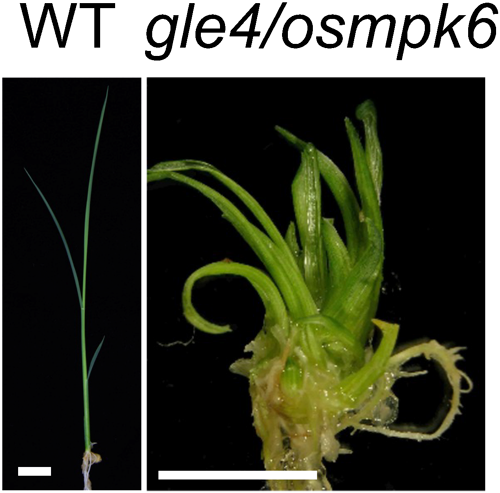- 著者
- Kiyoe Ishimoto Misuzu Nosaka-Takahashi Mitsuko Kishi-Kaboshi Tsuneaki Watanabe Kiyomi Abe Sae Shimizu-Sato Hirokazu Takahashi Mikio Nakazono Hirohiko Hirochika Yutaka Sato
- 出版者
- Japanese Society for Plant Biotechnology
- 雑誌
- Plant Biotechnology (ISSN:13424580)
- 巻号頁・発行日
- pp.22.1117a, (Released:2023-01-23)
- 参考文献数
- 25
In plants, mitogen activated protein kinases (MPKs) are involved in various signaling pathways that lead to biotic and abiotic responses as well as that regulate developmental processes. Among them, MPK6 and its closely related homologue, MPK3, act redundantly and are known to be involved in asymmetric cell divisions of meristemoid mother cells in stomata development and of zygotes in Arabidopsis. Loss-of-function mutants of GLE4/OsMPK6, which is an orthologue of MPK6 in rice, showed a defect in polarity establishment in early stage of embryogenesis. However, because of the embryo lethality of the mutations, the function of GLE4/OsMPK6 in post-embryonic development is not clarified. Here, we report the analysis of post embryonic function of GLE4/OsMPK6 in vegetative stage of rice using regenerated gle4/osmpk6 homozygous plants from tissue culture. The regenerated plants are dwarf and produce multiple shoots with small leaves. These shoots never develop into reproductive stage, instead, proliferate vegetative shoots repeatedly. Leaves of gle4/osmpk6 have small leaf blade at the tip and blade-sheath boundary become obscure. Stomata arrangement is also disturbed in gle4/osmpk6 leaf blade. The shape of shoot apical meristem of gle4/osmpk6 become disorganized. Thus, GLE4/OsMPK6 functions in shoot organization and stomata patterning in the post embryonic development in rice.
- 著者
- Yutaka Sato Katsutoshi Tsuda Yoshiyuki Yamagata Hiroaki Matsusaka Hiromi Kajiya-Kanegae Yuri Yoshida Ayumi Agata Kim Nhung Ta Sae Shimizu-Sato Toshiya Suzuki Misuzu Nosaka-Takahashi Takahiko Kubo Shoko Kawamoto Ken-Ichi Nonomura Hideshi Yasui Toshihiro Kumamaru
- 出版者
- Japanese Society of Breeding
- 雑誌
- Breeding Science (ISSN:13447610)
- 巻号頁・発行日
- vol.71, no.3, pp.291-298, 2021 (Released:2021-07-30)
- 参考文献数
- 62
- 被引用文献数
- 5
Biological resources are the basic infrastructure of bioscience research. Rice (Oryza sativa L.) is a good experimental model for research in cereal crops and monocots and includes important genetic materials used in breeding. The availability of genetic materials, including mutants, is important for rice research. In addition, Oryza species are attractive to researchers for both finding useful genes for breeding and for understanding the mechanism of genome evolution that enables wild plants to adapt to their own habitats. NBRP-RICE contributes to rice research by promoting the usage of genetic materials, especially wild Oryza accessions and mutant lines. Our activity includes collection, preservation and distribution of those materials and the provision of basic information on them, such as morphological and physiological traits and genomic information. In this review paper, we introduce the activities of NBRP-RICE and our database, Oryzabase, which facilitates the access to NBRP-RICE resources and their genomic sequences as well as the current situation of wild Oryza genome sequencing efforts by NBRP-RICE and other institutes.
- 著者
- Yutaka Sato Katsutoshi Tsuda Yoshiyuki Yamagata Hiroaki Matsusaka Hiromi Kajiya-Kanegae Yuri Yoshida Ayumi Agata Kim Nhung Ta Sae Shimizu-Sato Toshiya Suzuki Misuzu Nosaka-Takahashi Takahiko Kubo Shoko Kawamoto Ken-Ichi Nonomura Hideshi Yasui Toshihiro Kumamaru
- 出版者
- Japanese Society of Breeding
- 雑誌
- Breeding Science (ISSN:13447610)
- 巻号頁・発行日
- pp.21005, (Released:2021-06-26)
- 被引用文献数
- 5
Biological resources are the basic infrastructure of bioscience research. Rice (Oryza sativa L.) is a good experimental model for research in cereal crops and monocots and includes important genetic materials used in breeding. The availability of genetic materials, including mutants, is important for rice research. In addition, Oryza species are attractive to researchers for both finding useful genes for breeding and for understanding the mechanism of genome evolution that enables wild plants to adapt to their own habitats. NBRP-RICE contributes to rice research by promoting the usage of genetic materials, especially wild Oryza accessions and mutant lines. Our activity includes collection, preservation and distribution of those materials and the provision of basic information on them, such as morphological and physiological traits and genomic information. In this review paper, we introduce the activities of NBRP-RICE and our database, Oryzabase, which facilitates the access to NBRP-RICE resources and their genomic sequences as well as the current situation of wild Oryza genome sequencing efforts by NBRP-RICE and other institutes.
